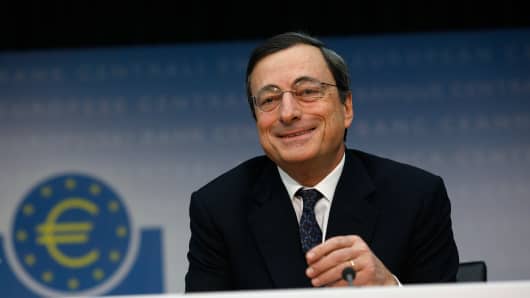Just over a week ago, Draghi spoke at the annual Jackson Hole Symposium, indicating that the euro zone's central bank might act on Thursday…all depending on the region's inflation data.
But while the head of the ECB provided a more dovish line, causing the euro to drop, a report from Reuters, quoting unnamed sources, stated that the ECB might NOT act … all depending on the euro zone inflation data. This caused the euro to rise.
Read MoreEuro zone inflation hits 5-year low; ECB action eyed
Amusing to me, given they in essence were stating the same thing: "The ECB's actions depend on the inflation data."
So will the ECB act?
Peter Rosenstreich, chief foreign exchange analyst from Swissquote Bank, thinks they won't, instead opting to wait and see if there are more effects from the June policy decision when they announced Targeted Long Term Refinancing Operation(TLTROs), and indicated a willingness to increase their dealing in asset backed securities (ABS).
The TLTROs are officially conducted this year on September 18 and December 11, and Rosenstreich says it will be important to see how many banks decide to participate in the offering. He also points out that while the real caveat remains inflation, from a data perspective, we're already in the red zone.
Read MoreEuro zone yields turn negative on Draghi hopes
Rosenstreich thinks it's almost inevitable that we will see quantitative easing in Europe, but as lending isn't the same as quantitative easing, the ECB may need to push liquidity out through asset purchases. Also, with resistance towards full-blown quantitative easing felt from former ECB head Jean-Claude Trichet and the German Bundesbank, the green light to go down this path is perhaps not as green as thought.
Where is the euro heading?
When it comes to the single currency, Rosenstreich thinks we could see some short-term wobbles, but supposing the ECB decides not to act on Thursday, the euro-dollar exchange rate will still be stuck in a trading range of $1.34 - $1.31. Rosenstreich sees this continuing until we get deflation or the chorus of central bankers becomes unified.
Read MoreEuro zone business activity slips, missing forecasts
At the moment, Draghi probably isn't seeing that much of a difference between 0.2 percent and 0.3 or 0.4 percent inflation. But were it to turn negative, the ECB would be forced to act immediately. Rosenstreich thinks there is a big chance the euro will be weaker by the end of 2014, trading around $1.30-$1.32, and through next year he anticipates significant weakening down to $1.25 as the gulf of recovery widens even more between the U.S. and Europe.
Ultimately, if the US Federal Reserve and the European Central Bank both act, that would really damage the euro.


